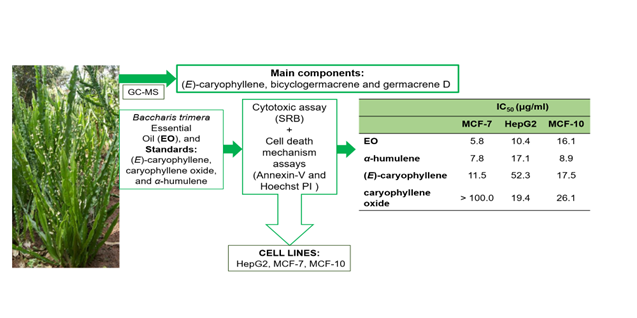Cytotoxic Activity of Baccharis trimera (Less.) DC. Essential Oil in Tumor Cell Lines and its Role in Associated Death Mechanisms

- Baccharis trimera, cancer, cytotoxic, essential oil
Copyright (c) 2023 Orbital: The Electronic Journal of Chemistry

This work is licensed under a Creative Commons Attribution-NonCommercial-NoDerivatives 4.0 International License.
Abstract
This study evaluated the potential of Baccharis trimera essential oil (EO) and its components in cancer therapy through the application of cytotoxicity and cell death assays. Using gas chromatography analysis, the major components of the aerial parts of the essential oil were identified as (E)-caryophyllene (18.9%), bicyclogermacrene (15.6%), and germacrene D (10.5%). Baccharis trimera essential oil (5.8 μg/mL) and α-humulene (7.8 μg/mL) presented strong cytotoxic activity, while (E)-caryophyllene (11.5 μg/mL) and caryophyllene oxide (> 100.0 μg/mL) showed moderate and low activities, respectively, against MCF-7 cell lines. Against HepG2 cell lines, B. trimera essential oil (10.4 μg/mL), α-humulene (17.1 μg/mL), and caryophyllene oxide (19.4 μg/mL) exhibited moderate activity, while (E)-caryophyllene (52.3 μg/mL) displayed low activity against HepG2 cell lines. The selectivity index values of EO (MCF-7 and HepG2), α-humulene and (E)-caryophyllene (MCF-7), and caryophyllene oxide (HepG2) were found between 1.1 and 2.8, compared with MCF-10A cells. The annexin-V and Hoechst / propidium iodide assays performed with essential oil, (E)-caryophyllene, α-humulene, and caryophyllene oxide showed apoptosis and necrosis mechanisms for all cell lines. Based on these findings, B. trimera essential oil and its components can be considered as potential therapeutic agents against cancer.





